V-3: Difference between revisions
Pbcjohnston (talk | contribs) (Created V-3 page) |
Pbcjohnston (talk | contribs) (Added fourth Boston photo) |
||
| (3 intermediate revisions by the same user not shown) | |||
| Line 1: | Line 1: | ||
[[File:Header 3 New.jpg]] | [[File:Header 3 New.jpg]] | ||
<div style="text-align: justify;"><span style="color:#00008B"> | [[File:Bonita post Launch 1.jpg|left|500px]] | ||
<div style="text-align: justify;"><span style="color:#00008B">V-3 waterborne for the first time in the Piscataqua River after her launching at the Portsmouth Navy Yard, Kittery, ME., June 9, 1925. Portsmouth stern launched all submarines built at the yard until 1960, when they switched to an unusual bow first launch method. USS Thresher (SSN-593) was the first bow launched submarine at the yard. | |||
<small> | <small>Photo in the private collection of Ric Hedman.</small> | ||
[[File:Red bar sub new.jpg]] | |||
[[File:Bonita post launch.jpg|left|500px]] | |||
<div style="text-align: justify;"><span style="color:#00008B">Taken shortly after the photo above, tugs are moving up to V-3 to move her to the fitting out pier. She has been elaborately trimmed with signal flags for the event. She had approximately 11 months of work to go before her commissioning. | |||
<small>Photo courtesy of the Milne Special Collections, University of New Hampshire Library, Durham, N.H. Used with permission.</small> | |||
[[File:Red bar sub new.jpg]] | |||
[[File:Bonita boston-1.jpg|left|500px]] | |||
<div style="text-align: justify;"><span style="color:#00008B">The USS V-3 moored at the Boston Navy Yard in Charlestown, MA., with the USS Constitution, "Old Ironsides" in the background. The date is not known for sure, but is believed to be between May, 1926 and November, 1927. The Signalman on top of the bridge is signaling with semaphore flags, creating the letter "R". He is standing on a watertight housing for a magnetic compass repeater. The windows of the covered pilothouse are visible on the front edge of the bridge fairwater, just forward of a watertight grommet for radio aerial wires. The open hatch above the "V3" leads to the aft engine room. Aft of the conning tower fairwater is the port small boat kingpost, the boom is laying at deck level. The men are standing on top the port boat storage decking. | |||
V-3's commanding officer at this time was LCDR Charles A. Lockwood, Jr., later to rise in rank to the rank of Vice Admiral with command of the Submarine Force, Pacific Fleet (COMSUBPAC). He was instrumental in developing the leadership and strategy in the highly successful submarine war against Japan. | |||
<small>Boston Public Library/National Archives Photo</small> | |||
[[File:Red bar sub new.jpg]] | |||
[[File:Bonita boston-2.jpg|left|500px]] | |||
<div style="text-align: justify;"><span style="color:#00008B">Another photo taken shortly after the one above, with the Signalman now signaling the letter "U". The numerous small holes in the side of the fairwater are limber holes. The fairwater is free-flooding and thus the limber holes allow the area to flood and drain as the boat dives or surfaces. The actual conning tower is a medium sized vertical cylinder that houses a periscope station and torpedo firing equipment. It is completely enclosed by the fairwater. Just forward of the conning tower and immediately behind the door-less oval opening is an access trunk that leads to the control room. This trunk is used by the gun crew to access the main deck during a gun action and is likely the path for the ammunition passing train from the magazine below the control room. | |||
There are good details of the 5"/51 caliber Mk 9 gun visible here and in the photo below. This was a large and heavy weapon that fired "semi-fixed" ammunition, meaning that the complete round (projectile + propellent charge) is stored connected together in the magazine, but the two can be easily separated for quicker handling. This would have been a necessity without a powered ammunition hoist. | |||
<small>Boston Public Library/National Archives Photo</small> | |||
[[File:Red bar sub new.jpg]] | |||
[[File:Bonita boston-3.jpg|left|500px]] | |||
<div style="text-align: justify;"><span style="color:#00008B">In this photo, V-3's Signalman is now making the letter "Y" with his flags. In the background behind the Constitution is the white superstructure of an Omaha-class light cruiser, quite possibly the [https://www.navsource.org/archives/04/007/04007.htm '''USS Raleigh (CL-7)'''], who was homeported there during this time frame. Behind the cruiser is the cage mast of a battleship. On the far left, just visible at the edge of the photo is a battleship gun turret, and it is not clear if this turret belongs to the same ship as the cage mast, or if it is another ship. The other ships are unidentified. Unlike today, the Boston Navy Yard was a busy and vibrant place for the USN of the 1920's and a favored port-of-call for warships of all types. | |||
<small>Boston Public Library/National Archives Photo</small> | |||
[[File:Red bar sub new.jpg]] | |||
[[File:V-3 alongside.png|left|500px]] | |||
V-3 moored at what is likely the Boston Navy Yard, approximately 1927. This is a fine bow shot, and it illustrates the unusual bow shape for these boats. The standard Navy stockless anchor is housed in a recess in the tip of the bow, with the shank and the shackle ring protruding all the way up into a bulge atop the hull directly above it. The impression one got from this configuration was that of a shark with some prey caught in its mouth | |||
Just behind the anchor shank housing bulge was a housing for the forward retractable radio mast. When not in use the mast would retract down into the pressure hull between the torpedo tubes. There was a similar unit all the way aft. The very tall masts fore and aft worked in conjunction with the extendable mast amidships on the conning tower fairwater, and were used to string the very long aerial wires needed for long range radio communications. The relatively low powered radio sets of the day required these long line antennas held high in order to send and receive signals at the ranges needed. | |||
<small>Photo courtesy of the Massachusetts Digital Commonwealth.</small> | |||
[[File:Red bar sub new.jpg]] | |||
[[File:Bonita golden gate.jpg|left|500px]] | |||
<div style="text-align: justify;"><span style="color:#00008B">V-3 seen here in late 1927 or early 1928 sailing out through the Golden Gate with the Marin headlands in the background. We know the time frame since in mid-1928 the 5"/51 caliber guns on the first 3 V-Boats were removed and replaced by smaller 3"/50 caliber guns. The V-3 clearly still has her 5"/51 gun. | |||
Directly behind the after deck of the submarine is the location where the North End of the Golden Gate Bridge will be constructed. This is known because of the presence of the Lime Point Light House seen at the right edge of the photo. The lighthouse is still there today although many of the buildings have been torn down around it. | |||
The very small building seen set on the shore to the left of the light house is the approximate position of the northwest bridge pier footing. | |||
<small>Photo in the private collection of Ric Hedman.</small> | |||
[[File:Red bar sub new.jpg]] | |||
[[File:Bonita marine raliway.jpg|left|500px]] | |||
<div style="text-align: justify;"><span style="color:#00008B">V-3 hauled out on a floating drydock/marine railway for upkeep. Date and location is uncertain, but is likely 1927 or 1928 in a Pacific coast port. | |||
<small>Photo in the private collection of Ric Hedman.</small> | |||
[[File:Red bar sub new.jpg]] | |||
[[File:Bonita at balboa 5-6-1934.jpg|left|500px]] | |||
<div style="text-align: justify;"><span style="color:#00008B">In 1931 V-3 was renamed Bonita and reclassified as SS-165. She is shown here pulling up to a mooring alongside the USS [[Dolphin|'''Dolphin (SS-169)''']] at Balboa, Panama, April, 1934. She and other Submarine Division 12 units and major fleet components; battleships, cruisers, tenders, etc, are passing through the canal to the Caribbean and Fleet Problem XV and then north to New York for the Presidential Review. Two battleships can be seen in the background of the photo, the one on the right is most likely the USS California (BB-44). Identity of the other isn't known at this time. The tugs probably belong to the canal authority since it seems the Navy did not keep any tugs there. | |||
The vessels in Bonita's group heading to New York from the Pacific included Submarine Division 12 with the USS Bushnell (AS-2), a tender and the flagship of Rear Admiral John W. Greenslade, Commander Submarine Force, U.S. Pacific Fleet. USS Holland (AS-3), another tender, and the USS Ortolan (ASR-5), a rescue vessel, accompanied them along with the submarines [[V-1|'''Barracuda (SS-163)''']], [[V-2|'''Bass (SS-164)''']], [[168|'''Nautilus (SS-168)''']], Dolphin (SS-169), and [[167|'''Narwhal (SS-167)''']]. The last being contingent on the completion of an overhaul at the Mare Island Navy Yard. | |||
Various components of the combined fleet went their own ways for the various war game aspects of "Fleet Problem XV". The outcome of these war games is that for the first time, commanders were encouraged to "emphasize on decisive offensive action, reliance on individual initiative, and development of decentralized command and control". | |||
<small>Photo in the private collection of Ric Hedman.</small> | |||
[[File:Red bar sub new.jpg]] | |||
[[File:Bonita Narwhal.jpg|left|500px]] | |||
<div style="text-align: justify;"><span style="color:#00008B">Narwhal (SS-167) is moored next to Bonita, circa 1935. Location is unknown, but is possibly San Pedro (Los Angeles) or San Diego. Narwhal has already been painted black, but Bonita retains her haze gray scheme, indicating that the date of this photo was during the transition between the two schemes in 1935. Bonita was a big boat for her day, but Narwhal dwarfed her in size. Two of Narwhal's boats are in the water between the two subs. | |||
<small>Photo in the private collection of Ric Hedman.</small> | |||
[[File:Red bar sub new.jpg]] | [[File:Red bar sub new.jpg]] | ||
Latest revision as of 16:27, 20 September 2024
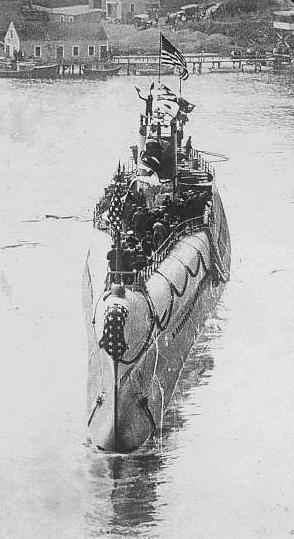
Photo in the private collection of Ric Hedman.
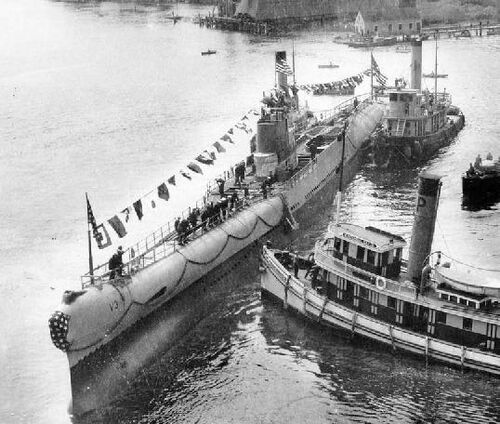
Photo courtesy of the Milne Special Collections, University of New Hampshire Library, Durham, N.H. Used with permission.
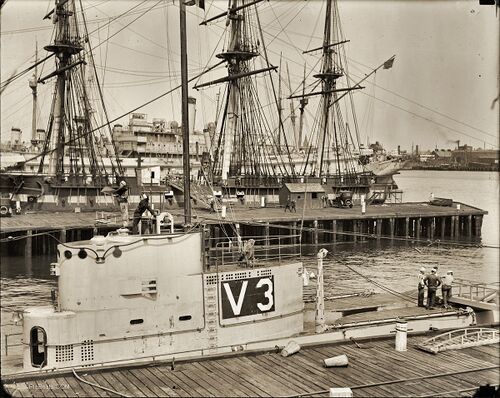
V-3's commanding officer at this time was LCDR Charles A. Lockwood, Jr., later to rise in rank to the rank of Vice Admiral with command of the Submarine Force, Pacific Fleet (COMSUBPAC). He was instrumental in developing the leadership and strategy in the highly successful submarine war against Japan.
Boston Public Library/National Archives Photo
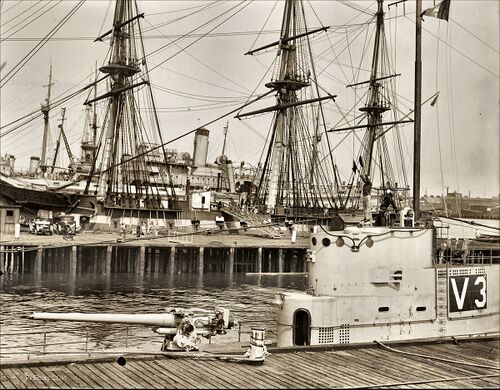
There are good details of the 5"/51 caliber Mk 9 gun visible here and in the photo below. This was a large and heavy weapon that fired "semi-fixed" ammunition, meaning that the complete round (projectile + propellent charge) is stored connected together in the magazine, but the two can be easily separated for quicker handling. This would have been a necessity without a powered ammunition hoist.
Boston Public Library/National Archives Photo
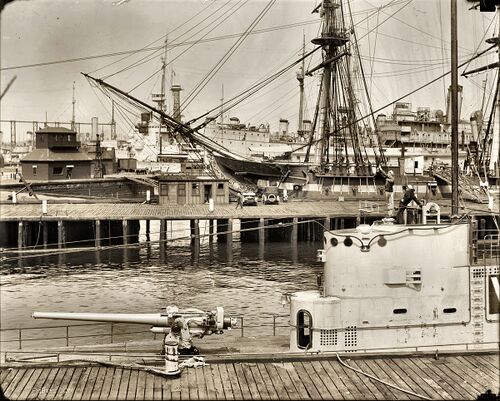
Boston Public Library/National Archives Photo
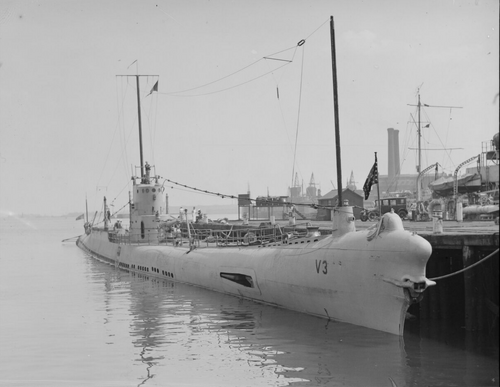
V-3 moored at what is likely the Boston Navy Yard, approximately 1927. This is a fine bow shot, and it illustrates the unusual bow shape for these boats. The standard Navy stockless anchor is housed in a recess in the tip of the bow, with the shank and the shackle ring protruding all the way up into a bulge atop the hull directly above it. The impression one got from this configuration was that of a shark with some prey caught in its mouth
Just behind the anchor shank housing bulge was a housing for the forward retractable radio mast. When not in use the mast would retract down into the pressure hull between the torpedo tubes. There was a similar unit all the way aft. The very tall masts fore and aft worked in conjunction with the extendable mast amidships on the conning tower fairwater, and were used to string the very long aerial wires needed for long range radio communications. The relatively low powered radio sets of the day required these long line antennas held high in order to send and receive signals at the ranges needed.
Photo courtesy of the Massachusetts Digital Commonwealth.

Directly behind the after deck of the submarine is the location where the North End of the Golden Gate Bridge will be constructed. This is known because of the presence of the Lime Point Light House seen at the right edge of the photo. The lighthouse is still there today although many of the buildings have been torn down around it.
The very small building seen set on the shore to the left of the light house is the approximate position of the northwest bridge pier footing.
Photo in the private collection of Ric Hedman.

Photo in the private collection of Ric Hedman.
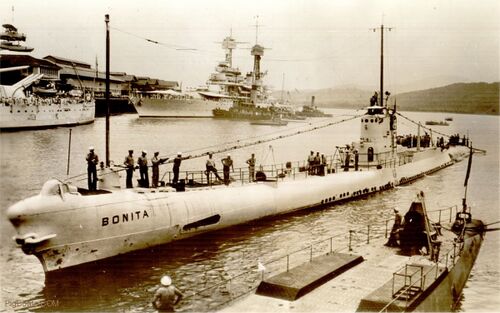
The vessels in Bonita's group heading to New York from the Pacific included Submarine Division 12 with the USS Bushnell (AS-2), a tender and the flagship of Rear Admiral John W. Greenslade, Commander Submarine Force, U.S. Pacific Fleet. USS Holland (AS-3), another tender, and the USS Ortolan (ASR-5), a rescue vessel, accompanied them along with the submarines Barracuda (SS-163), Bass (SS-164), Nautilus (SS-168), Dolphin (SS-169), and Narwhal (SS-167). The last being contingent on the completion of an overhaul at the Mare Island Navy Yard.
Various components of the combined fleet went their own ways for the various war game aspects of "Fleet Problem XV". The outcome of these war games is that for the first time, commanders were encouraged to "emphasize on decisive offensive action, reliance on individual initiative, and development of decentralized command and control".
Photo in the private collection of Ric Hedman.
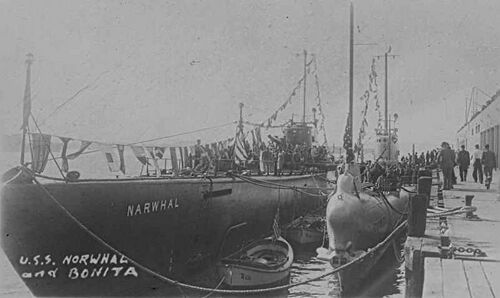
Photo in the private collection of Ric Hedman.
Page created by:
Ric Hedman & David Johnston
1999 - 2023 - PigBoats.COM©
Mountlake Terrace, WA, Norfolk, VA
webmaster at pigboats dot com
